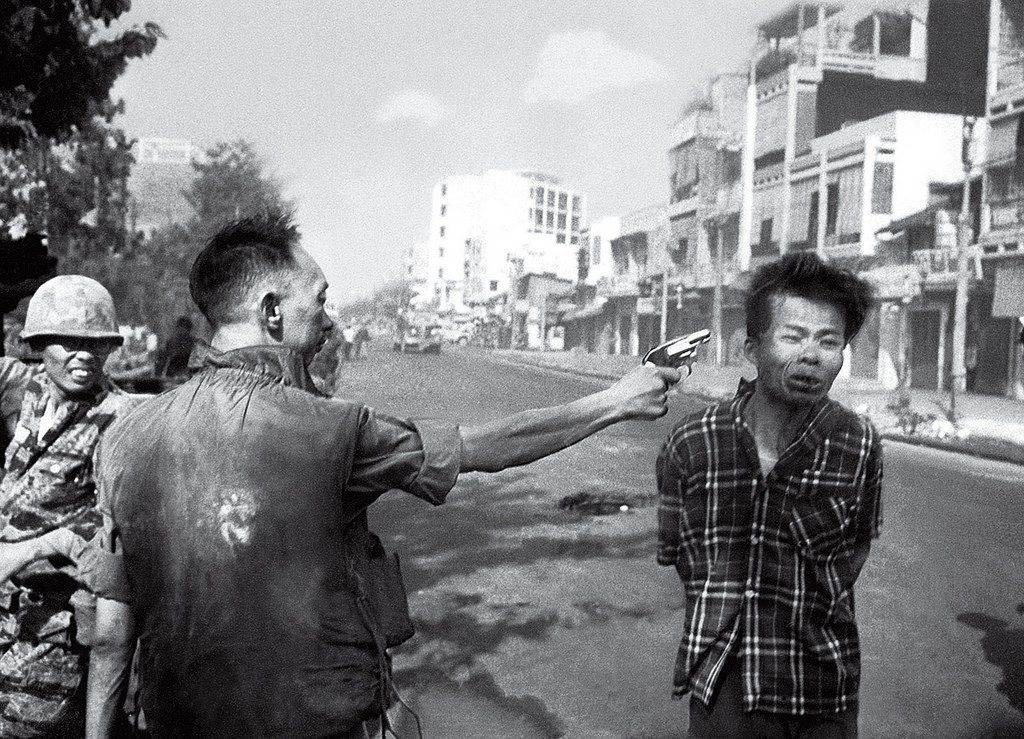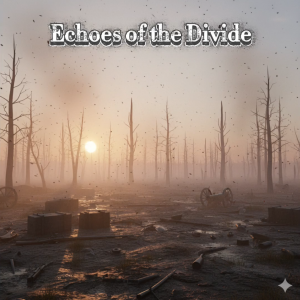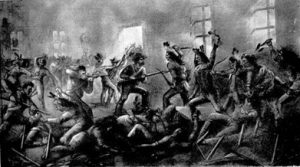Winner of the Fall 2018 StMU History Media Award for
Article with the Best Use of Images
Article with the Best Introduction
The year was 1968. The month of January was almost over and “Tet,” the Vietnamese Lunar New Year, was about to begin. By now, Vietnam had been embroiled for years in a civil war. North Vietnam was under the leadership of a Communist government and South Vietnam was under the leadership of a government that was backed by West. The start of Tet in 1968 was used to launch a huge offensive by the Vietcong in which coordinated attacks took place all over South Vietnam to destabilize the region and push the United States to withdraw.1
The United States‘ intervention in Vietnam began in 1965, a year after the unwarranted attacks by North Vietnam on United States‘ Destroyer ships in the Gulf of Tonkin. By 1967, the number of American troops on the ground surged.2 Despite being involved in this conflict halfway across the globe, the war did not seem so distant with the steady stream of footage and photographs from the front-lines directly to living rooms all over America. In this regard, Vietnam was unique for being one of the first wars to be filmed and photographed extensively.3 The work done by journalists in Vietnam allowed the world to see what was happening in Vietnam firsthand. Among those in Vietnam documenting the war was Eddie Adams.
Eddie Adams had been involved with photography since an early age. He had been a photographer for his high school newspaper and had done some photography work for weddings. Upon graduating high school, he enlisted in the United States Marine Corp. As a Marine, Adams served as a combat photographer in Korea for almost 3 years. In 1965, in what he describes as an “alcoholic haze,” Adams and a close friend decided they would go to Vietnam to document the war.4 During his time in Vietnam is when Adams took the photograph of the Saigon execution.
The day Adams shot the picture featured above was February 1st. He recalls himself and NBC journalists heading toward Cholon, a section of the city of Saigon, because they heard of a battle taking place there. Adams came upon South Vietnamese Brigadier General Nguyen Ngoc Loan executing a Vietcong soldier, in cold blood, in broad day light, in the middle of the street. Adams recalls himself and the other journalist gathering around Loan as he grabbed the soldier. Adams assumed Loan was only going to threaten the man. In the instant Adams raised his camera to snap a photo, Loan raised his pistol and executed the soldier. Loan explained after, that the Vietcong soldier had killed many Americans and allied Vietnamese soldiers.5
The photograph showed up on all major news evening broadcasts and on the front cover of newspapers all over the world the next morning.6 The execution was also recorded, but the specific angle Adams got in his photograph showed the war in an indescribable way. Peter Braestrup, one of the most versed individuals on the Tet offensive, described the picture as a “kind of ultimate horror story that you captured in living color. But in terms of information it told you almost nothing.”7 His quote could not do more justice. What the world saw was a man who was wincing before certain death. They did not know the man was a part of the Vietcong. In the photograph, he seems to be wearing civilian clothes which misleads one. The man had also recently killed allied soldiers and was found armed during martial law- an offense that justifies the use of force.8 Eddie Adams believed he had done an injustice to Loan. He explained, “General Loan was our guy. We were supporting him… believe me, the Americans did just as bad things. I just happened to see this and shoot it…”9

Despite the Johnson Administration’s attempt to win public support of the war, the images of the war painted a very different picture. Public opinion felt that the war was no longer winnable, rather it was now a matter of how America could save face. Walter Cronkite, a well-respected news-anchor and a strong supporter for the war, was among those whose opinion shifted. It was reported that President Johnson believed “if I lost Cronkite, I’ve lost America.”10 The irony of it all was that the Tet Offensive was largely a failure for the Vietcong in terms of land gained and damage inflicted, but in the end its psychological impact on how Americans believed the war to be going, led to its success.11

While this photo was taken out of context, it did provide small truths of the war. Although the war was going well, horrendous acts were being committed. Eddie Adams and many others were able to expose the world to the atrocious acts being committed during the war. Nick Ut’s photo of a napalm strike on a village, is another photo that came to define the war. Ut’s photograph captured the moment children run away in horror from napalm strikes on their village.12 The shattered innocence and utter despair on the childrens’ faces while soldiers seem calm provides a stark incomprehensible contrast that pulls at the heart. These photographs captured only instances of the war. But in the frozen state of a photograph, one is able to examine and reexamine a photograph and truly take in all its details. There was no propaganda campaign that could ever keep a just people supporting a war when they saw photographs like these.

As journalist, Adams and the others were simply doing their jobs. Horst Faas explained about documenting the war, “I don’t think we influenced the war… [he believed simply that the job of journalist was to] record the suffering, the emotions and the sacrifices of both the Americans and the Vietnamese…”13 Their work allowed for the false reality America was living to fall apart. As Americans lived, worked, and played, the very basic rights all humans are entitled to were violated by both sides. As such, Americans responded. In 1973, with public support overwhelmingly against the war in Vietnam, the United States signed the Paris Agreement that led to the withdrawal of all American troops.14 The involvement of the United States in Vietnam continues to be synonymous with some of the most appalling violations of human rights, not only violations against Vietnamese civilians burned alive with napalm or killed slowly through cancer with massive exposure to Agent Orange, but also of the atrocities committed or witnessed by US forces. In addition, all US Soldiers exposed to Agent Orange in indirect ways as when combat medics who worked at Clark Air Force Base (Philippines Islands) received the US soldiers injured in Vietnam who had been evacuated by air. These combat medics received soldiers injured in the field in Vietnam covered in Agent Orange with no protocol for decontamination for the injured nor for themselves as medical personnel. Fifty years on and they continue to die from cancers caused by exposure to Agent Orange. While the US left in 1973, the human suffering due to human rights violations done then, continues today. These images changed the public opinion and changed the course of history even when they may have not saved all those involved at the time, they avoided even greater damages and loss of life, for that we are grateful to these powerful images.
- Patrick Hagopian, America in the World, 1776 to the Present: A Supplement to the Dictionary of American History (Farmington Hills, MI: Charles Scribner’s Sons, 2016), 752. ↵
- James H. Willbanks, Vietnam War: A Topical Exploration and Primary Source Collection (Santa Barbara, CA: ABC-CLIO, 2017), 133, 183. ↵
- James H. Willbanks, The Tet Offensive: A Concise History (New York: Columbia University Press, 2007), 5-6. ↵
- Encyclopedia of World Biography, 2nd Edition, s.v. “Eddie Adams” (Detroit: Gale, 2005), 4. ↵
- Encyclopedia of World Biography, 2nd Edition, s.v. “Eddie Adams” (Detroit: Gale, 2005), 4. ↵
- David Culbert, Television’s Visual Impact on Decision-Making in the USA, 1968: The Tet Offensive and Chicago’s Democratic National Convention, Journal of Contemporary History Vol. 33 (1998): 421. ↵
- David Culbert, Television’s Visual Impact on Decision-Making in the USA, 1968: The Tet Offensive and Chicago’s Democratic National Convention, Journal of Contemporary History Vol. 33 (1998): 424. ↵
- David Culbert, Television’s Visual Impact on Decision-Making in the USA, 1968: The Tet Offensive and Chicago’s Democratic National Convention, Journal of Contemporary History Vol. 33 (1998): 423, 426-428 ↵
- Encyclopedia of World Biography, 2nd Edition, s.v. “Eddie Adams” (Detroit: Gale, 2005), 4-5. ↵
- James H. Willbanks, Vietnam War: A Topical Exploration and Primary Source Collection (Santa Barbara, CA: ABC-CLIO, 2017), 255. ↵
- James H. Willbanks, Vietnam War: A Topical Exploration and Primary Source Collection (Santa Barbara, CA: ABC-CLIO, 2017), 249 ↵
- Hal Buell, The Napalm Girl, Vietnam 25, no. 1 (June 2012), 36-39. ↵
- Deborah Stadler, Frontline Focus, Military History 33, no. 6 (March 2017), 56-61. ↵
- “12 Address to the Nation Announcing Conclusion of an Agreement on Ending the War and Restoring Peace in Vietnam. January 23, 1973.” 2001. American Reference Library – Primary Source Documents, (January, 1.) ↵



188 comments
Luke Lopez
This was a very interesting article on the picture that ended the Vietnam War. I did not know that Eddie Adams was the person who took the famous picture in Vietnam. I also did not know that the person who was about to be executed was a Viet Cong lieutenant who had just killed allied soldiers. Overall, this was a great article that detailed the impact that this picture had on the Vietnam War.
Christopher Hohman
Wow what a great article. And the pictures you used are really great also. They really capture how terrible the Vietnam war was. That first picture is so sad because even though that man was our enemy in that moment before his death he was nothing but an ordinary man who was afraid for his life. I also really find the image of the children running away from that poison gas is also really sad. It is so terrible that children had to suffer. They had no business suffering during the war.
Cynthia Rodriguez
I personally am not too familiar with the Vietnam War, but what I found interesting is that it was one of the first wars that was filmed and photographed a lot. It was this documentation of the war that allowed people to experience the war for themselves. I had never heard of the photographer Eddie Adams, nor had I heard of the picture he shot moments before a soldier was executed. As pointed out in the article, it is hard to tell that the man is a solder since he is in civilian clothes. It really is crazy how much a picture can do and the effects it could cause. This picture is gave people a glimpse of the terrible things being committed in the war. This picture was not even purposely taken to cause a change in the war; it was simply taken as a part of Adams’ job, but I think it is amazing that this powerful image managed to increase the opposition of the Vietnam War. This was a well-written article. It was informative and it had great images. Good job!
Marina Castro
Great job Jose! Congratulations for the nominations you got for your article. Every single time I read this article I am amazed by it. Starting from the moment you see the featured image and start reading the first lines, the reader already is fully engaged with the article. I can tell by the comments that everyone who has read this article feels the same way that I do.
Luisa Ortiz
Jose, I knew you were going to be nominated! because the images you choose are excellent, eye-catching, touching, and they are part of history! again Congratulations on this nomination! My absolutely favorite picture from your article is the one with the caption: ” South Vietnamese forces flee with civilians after napalm is accidentally dropped on a friendly village| June 8th, 1972″. Even though is a sad picture is very powerful and eye-opening!
Adrian Cook
You know what they say, pictures are worth a thousand words. Being able to capture moments in a still photo doesn’t do enough justice but only helps the person observing wonder what could’ve possibly been going through the minds of the people depicted. These are very scary photos but just shows what these citizens of Vietnam had to go through. The Vietnam War caused many lives to be lost, innocent included. I’m glad people were able to capture these harsh realities to show the actions of the military.
Rylie Kieny
The pictures included int his article tell a thousand words. A thousand words of pain and suffering that the war caused for many. This was the first time a war was covered by television and newspapers so these images were very shocking to the masses. Only those who had experienced war could really understand what was taking place overseas. It was pictures such as these that showed war to the world. The pictures of the children are what hit the hardest because children are innocent yet still feel the horrible effects of war.
Lyzette Flores
It is sad to know that many innocent people lose their life for something they did not cause nor can control. For example, those innocent children in the picture. They look terrified and they did not do anything to be in that position. That picture definitely describes more than words can. Many people always hear about tragic events going around the world and feel bad but when you actually see pictures of it, it makes you look at it differently.
Kaitlyn Killebrew
I hope this article gets awarded for best pictures. The despair on the mans face as the gun is brought up to his head or the children running is bone chilling. I knew at the time that Nixon was president and he tried to downplay the Vietnam war but because this was one of the first wars ever to be televised, people across the ocean got to see what was actually going on. In the description it said that napalm was accidentally dropped on a friendly village, at this point our soldiers were doing more harm than good.
Megan Copeland
I did not have a lot of knowledge on the Vietnam War prior to reading this article. I think the images used in this article were great which is why it got nominated for the award. While the Vietnam war was going on, there was so much sadness in the United States, because it was causing so many casualties. I am glad that it finally ended, but sad that so many people had to lose their lives to this war.